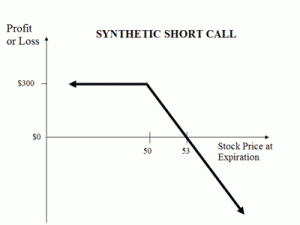You short a call when you write (sell) a call that you don’t currently own. There are two basic types of short calls covered and uncovered (naked). The investor writing Call options should firmly believe that XYZ is not going up! XYZ doesn’t have to go down, but it most definitely cannot go up. This is because the strategy’s break-even point at expiration is a certain distance above the then current stock price. Thus, depending on the option’s strike price, writing Call options can be a viewed as a neutral to bearish strategy.
Risk/Reward Characteristics
Break-even Point: At expiration, the break-even point (B.E.) is equal to the strike price of the Call option plus the Call option’s premium. Before expiration, the break-even point is lower.
Profit: Profits are limited no matter how large the decline in XYZ.
Loss: Losses are unlimited!!
Time Decay: A Call option’s premium consists of both intrinsic value (if any) plus time value. As time passes, the time value portion of the Call erodes (i.e., decays). At expiration, the Call’s value will equal its intrinsic value.
Changes in implied Volatility: Changes in the option’s implied volatility has an effect on the “time value” portion of an option’s premium.
When the stock falls below the strike price of the call options by expiration, the call options expire worthless and the entire premium from sale is earned.
When you short sell, you are actually selling a security without owning it, hoping that you can buy it later when the price falls and repay your loan.

OBAMA and Bernanke are featured in a movie– about short selling and greedy hedge funds called “Stock Shock.” Even though the movie mostly focuses on Sirius XM stock being naked short sold nearly into bankruptcy (5 cents/share), I liked it because it exposes the dark side of Wall Street and revealed some of their secrets. DVD is everywhere but cheaper